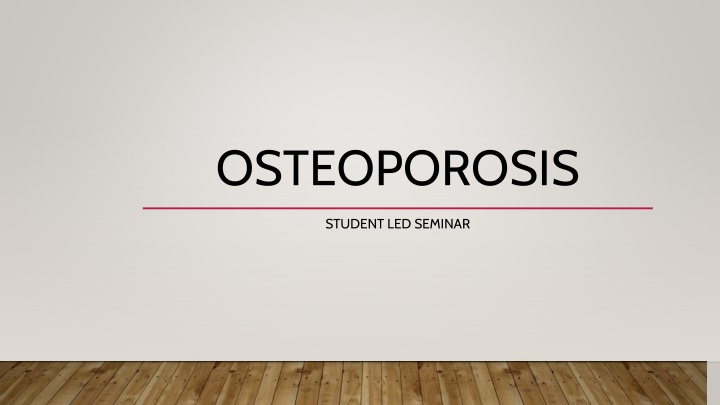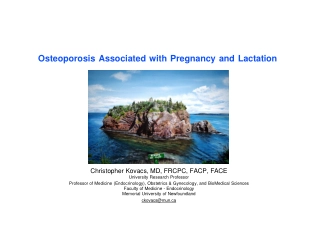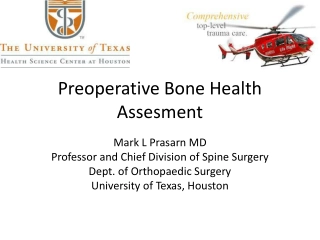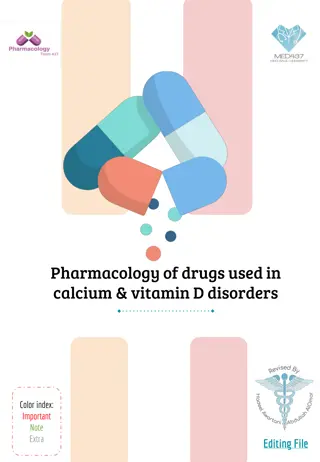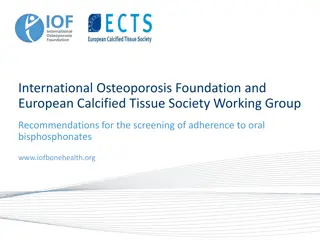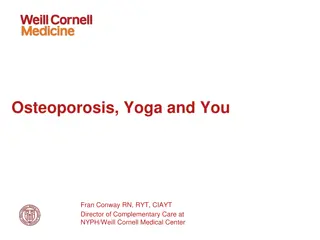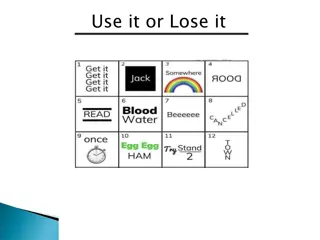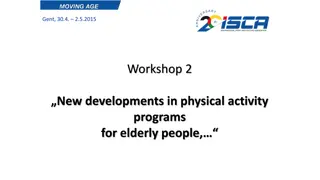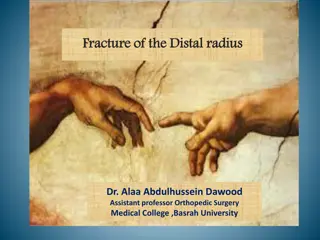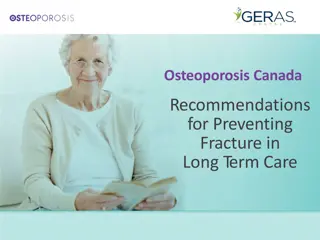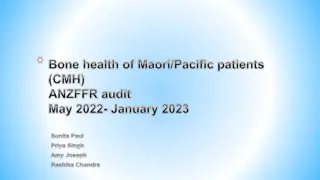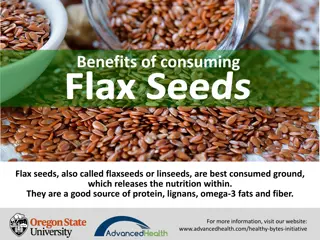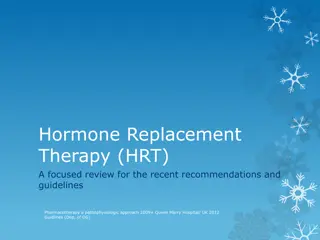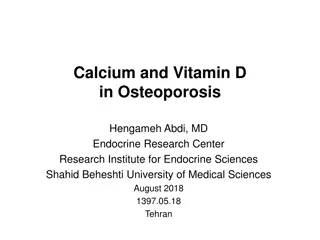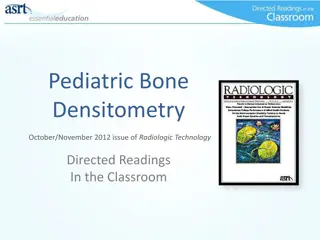OSTEOPOROSIS
Osteoporosis is characterized by low bone mass, micro-architectural disruption, and increased skeletal fragility, leading to a higher risk of fractures. This seminar covers primary and secondary causes, Vitamin D deficiency, risk factors, and the global prevalence of osteoporosis, particularly focusing on Saudi Arabia. Learn about the implications of Vitamin D deficiency and the various risk factors associated with osteoporosis.
Download Presentation

Please find below an Image/Link to download the presentation.
The content on the website is provided AS IS for your information and personal use only. It may not be sold, licensed, or shared on other websites without obtaining consent from the author.If you encounter any issues during the download, it is possible that the publisher has removed the file from their server.
You are allowed to download the files provided on this website for personal or commercial use, subject to the condition that they are used lawfully. All files are the property of their respective owners.
The content on the website is provided AS IS for your information and personal use only. It may not be sold, licensed, or shared on other websites without obtaining consent from the author.
E N D
Presentation Transcript
OSTEOPOROSIS STUDENT LED SEMINAR
DEFINITIONS Osteoporosis: Characterized by low bone mass (osteopenia), micro-architectural disruption, and increased skeletal fragility resulting in an increased risk of fracture DESPITE normal mineralization. Primary: Disease of post-menopausal women and elderly men. Secondary: Due to an obvious cause: steroid use, immobilization, hyperthyroidism, Vit D deficiency. Rickets: Deficient mineralization of bone and cartilage that occurs BEFORE closure of growth plates. Osteomalacia: Deficient mineralization of bone that occurs AFTER closure of growth plates.
VITAMIN D DEFICIENCY Normal Range 75 250 nmol/L Insufficient 25 74 nmol/L
VITAMIN D DEFICIENCY CONT. Risk factors for vitamin D deficiency: Decreased sun exposure Malnutrition Obesity Darker skin color Malabsorption e.g. celiac, IBD, short bowel syndrome Urban living conditions (due to pollution)
CONSEQUENCES OF VITAMIN D DEFICIENCY Rickets Osteomalacia Osteoporosis Depression Muscle aches and weakness, especially in the limb girdles Periodontitis Pre-eclampsia
PREVALENCE OF OSTEOPOROSIS Worldwide, it is estimated that 200 million people have osteoporosis. In the United States in 2010 about 8 million women and one to 2 million men had osteoporosis. In the developed world, 2% to 8% of males and 9% to 38% of females are affected There are 8.9 million fractures worldwide per year due to osteoporosis. USA spends an estimated 19 billion USD annually for related healthcare costs.
PREVALENCE OF OSTEOPOROSIS In Saudi Arabia, osteoporosis is already a serious issue. A report in the eastern region of Saudi Arabia indicates an incidence of postmenopausal osteoporosis (PMO) of 30 percent to 40 percent, with over 60 percent of postmenopausal women already having some degree of osteopenia.
RISK FACTORS OF OSTEOPOROSIS Nonmodifiable: Age. (Most important risk factor) Female gender Manopause Family history Small frame/low body weight History of broken bones Modifiable: Low Ca/Vitamin D Sedentary lifestyle Smoking Alcohol use
RISK FACTORS OF OSTEOPOROSIS Medical diseases: Premature menopause Malabsorption Chronic liver disease IBD Medications: Steroids L-Thyroxine Phenytoin and Barbiturates Thiazolidinediones Chronic Lithium use
MeCQs? What are the most common fractures you may see in osteoporosis patient ? k- scapula l- ethmoid m- coccyx n- sacrum o- hip p- temporal q- humerus r- elbow s- eye orbit t- clavicle u- hard palate v- ASI x- nasal cartilage y- everywhere z- no fracture a- Skull b- vertebra c- tibial tuberosity d- metatarsal e- nasal f- mandibular g- true rib h- false rib i- phalanx j- wrist
HOW OSTEOPOROSIS PATIENT PRESENT ? Osteoporosis is a silent disease, potentially lethal (brother of HTN). Pathway of presentation: Reduced bone strength Fragile bones minor trauma Fracture. Other common presentation: height shrinking, bent or stooped posture. Consider Back Pain as a sign of osteoporosis, caused by collapsed or fractured vertebrae. Can present with pain after minimal trauma, falls and lifting heavy objects.
SPINAL FRACTURES Called compression or wedge fracture Can be caused by lifting heavy or light objects, bending forward. Cause kyphosis
HIP FRACTURES Majority caused by falling down. The most devastating fracture and has huge impact on quality of life. Risk factor for other condition: DVT Increase in Mortality rate up to 50% in the following year after the fracture. Types: 1- Femoral neck fracture 2-Intertrochanteric hip fracture
WRIST AND FOREARM FRACTURES Colles Fracture: fracture of the distal end of the radius Most commonly caused by fall on a stretched hand Scaphoid fracture is less commonly in patient with osteoporosis
VITAMIN D AND COMORBIDITIES Cardiovascular System Hypertension Obesity Diabetes
CVS From the data of the National Health and Nutrition Examination Study (NHANES) 2001 to 2004, the prevalence of coronary heart disease (angina, myocardial infarction) ,heart failure and peripheral arterial diseases was more common in adults with 25-hydroxycholecalciferol levels <20 ng/mL compared with 30 ng/mL.
CVS In one of the largest trials, there was no beneficial effect on cardiovascular or metabolic risks after increasing baseline 25- hydroxycholecalciferol levels from 23 to well above 40 ng/mL (58 to 100 nmol/L).
HYPERTENSION In Observational studies, normotensive and hypertensive individuals, there is an inverse association between 25-hydroxycholecalciferol concentration and blood pressure. In meta-analysis of 10 trials , there was a nonsignificant reduction in systolic blood pressure (weighted mean difference -1.9 mm Hg) with vitamin D supplementation, but no effect on diastolic blood pressure.
OBESITY The prevalence of Vitamin D deficiency was considered high in obese adolescents. In several studies, obesity was associated with low 25- hydroxycholecalciferol concentration.
DIABETES MELLITUS TYPE 2 In several cross-sectional studies, type 2 diabetes and conditions known to be part of the metabolic syndrome were associated with a poor vitamin D status. However, in a systematic review of three longitudinal cohort studies, the association was not consistent. From the data of two cohorts, there was an association between higher vitamin D concentrations and lower risk for developing diabetes . In a meta-analysis of eight trials evaluating the effect of vitamin D supplementation on glycaemia, there was no effect of supplementation on glycaemia or incident diabetes.
OSTEOPOROSIS INVESTIGATIONS
CASE SCENARIO 65 years old woman came to your clinic for routine check up. She were ok despite some abdominal bloating after eating. In completing the appropriate screening tests, you order (DXA) to evaluate whether the patient has osteoporosis. DXA results reveal a T-score of 3.0 at the total hip and 2.7 at the femoral neck. Osteoporosis was diagnosed, you requested Blood tests which came as the following Calcium: 8.2 mg/dL LOW 25,OH vitamin D: 12 ng/mL (optimal > 25) LOW Liver enzymes including alkaline phosphatase: normal WBC: 7700/ L Hg: 10.3 g/dL LOW HCT: 32 g/dL LOW MCV 68 LOW PLT: 255,000/ L What do you think her problem? Is it primary or secondary?
LABORATORY What is the aim of conducting such invistgation? What are the lab results that interest you and why? Ca PO4 Vitamin D Creatinine TSH PTH if low what would you request further? CBC Alkaline Phosphatase
X-RAY X-ray is an obsolete modality to diagnose or screen osteoporosis No positive findings unless that you lost almost 50% of your bone density
DEXA DEXA (dual-energy x-ray absorptiometry) scan is the gold standard Sites selected are femoral neck and lumbar spine. Compare the bone mineral density (BMD) of bone with a standard control, which is the bone density of a healthy 30-year-old person (T-score). T-score and Z-score express Stander Deviation gap between control and patient. (T-scores) are used in all postmenopausal and perimenopausal women, and in men over age 50. In all other patients (including premenopausal women), z-scores are used. Z-score is the result of comparing BMD of the patient with healthy matched individual(control)
Z-score below < -2 indicates bone deficit that prompt searching the reason
65 years old woman came to your clinic for routine check up. She were ok despite some abdominal bloating after eating. In completing the appropriate screening tests, you order (DXA) to evaluate whether the patient has osteoporosis. DXA results reveal a T-score of 3.0 at the total hip and 2.7 at the femoral neck. Osteoporosis was diagnosed, you requested Blood tests which came as the following Calcium: 8.2 mg/dL LOW 25,OH vitamin D: 12 ng/mL (optimal > 25) LOW Liver enzymes including alkaline phosphatase: normal WBC: 7700/ L Hg: 10.3 g/dL LOW HCT: 32 g/dL LOW MCV 68 LOW PLT: 255,000/ L What do you think her problem? Is it primary or secondary?
Although most women with osteoporosis will have primary osteoporosis, her hypocalcemia and low vitamin D levels suggest that this woman s osteoporosis is due to a secondary cause. The GI symptoms and the iron deficiency anemia suggest that her hypovitaminosis D and low calcium is due to intestinal malabsorption
What is the drug of choice for management of adrenal glucocorticoid-induced osteoporosis? A-Alendronate B-Calcitonin C-Estrogen D-Ketoconazole
OBJECTIVES TO BE COVERED 1. Management of osteoporosis and osteopenia 2. Role of medications 3. Role of vitamin D and Ca 4. Vitamin deficiency during pregnancy 5. Prevention and advice
1-MANAGEMENT OF OSTEOPOROSIS AND OSTEOPENIA What do we mean by osteoporosis and osteopenia ? Osteoporosis: is a disease in which there is a reduction in trabecular bone mass resulting in a porous bone Osteopenia: is the stage before osteoporosis(T score=-1 - -2.5)
1-MANAGEMENT OF OSTEOPOROSIS AND OSTEOPENIA The management could be divided into two parts 1. Non-pharmacological therapy 2. Pharmacological therapy
1-MANAGEMENT OF OSTEOPOROSIS AND OSTEOPENIA 1. Non-pharmacological therapy Diet: -Adequate calorie intake -enough of Vit D and Ca Exercise: weight-bearing exercises Smoking cessation: because smoking accelerates bone loss Eliminate or reduce alcohol Avoid drugs that affect the bone (glucocorticoids)
1-MANAGEMENT OF OSTEOPOROSIS AND OSTEOPENIA 2. Pharmacological therapy Who needs Pharmacological therapy? 1-Postmenopausal women with established osteoporosis(T score=-2.5 or less) 2-high-risk postmenopausal women (T score=-1.0 to -2.5)
2-ROLE OF MEDICATIONS What medications do we use for osteoporosis? 1) Bisphosphonates: -first-line of treatment -Example:alendronate .. drug of choice for management of adrenal glucocorticoid-induced osteoporosis -MOA: decrease the activity of osteoclast and increase their apoptosis -Watch out for jaw osteonecrosis 2) Selective estrogen receptor modulator(raloxifine): -Used if bisphosphonates are not tolerated or counterindicated -it does not increase the risk of endometrial or breast cancer
2-ROLE OF MEDICATIONS 3)calcitonin: used as a nasal spray 4)PTH therapy (teriparatide) -given subcutaneously -given once daily and not continuously why? -used for less than 2 years (risk of osteosarcoma) 5)Denusomab: Monoclonal antibody that decreases osteoclast activation
3-ROLE OF VITAMIN D AND CA Ca : building block of bones Vitamin D : Help in absorbing Ca. They work together to maintain your bones health.
3-ROLE OF VITAMIN D AND CA Ca: Normal serum calcium level=8.5-10.5 mg/Dl Ca Bone 99% Blood 1% Complexed 10% Non- Bound 60% Bound 40% free 50%
